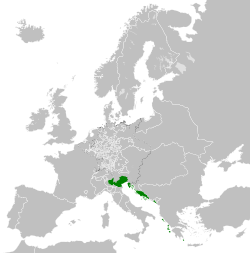
Republic of Venice
Sovereign state in Italy (697–1797) / From Wikipedia, the free encyclopedia
Dear Wikiwand AI, let's keep it short by simply answering these key questions:
Can you list the top facts and stats about Republic of Venice?
Summarize this article for a 10 year old
The Republic of Venice (Italian: Repubblica di Venezia; Venetian: Repùblega de Venèsia) or Venetian Republic,[lower-alpha 1] traditionally known as La Serenissima,[lower-alpha 2] was a sovereign state and maritime republic in parts of the present-day Italian Republic that existed for 1,100 years from 697 until 1797.[2] Centered on the lagoon communities of the prosperous city of Venice, it incorporated numerous overseas possessions in modern Croatia, Slovenia, Montenegro, Greece, Albania and Cyprus.[4] The republic grew into a trading power during the Middle Ages and strengthened this position during the Renaissance. Most citizens spoke the Venetian language, although publishing in Italian became the norm during the Renaissance.
Most Serene Republic of Venice | |||||||||||||||
|---|---|---|---|---|---|---|---|---|---|---|---|---|---|---|---|
| 697–1797 | |||||||||||||||
Coat of arms
(16–18th cent.) | |||||||||||||||
| Motto: Viva San Marco | |||||||||||||||
| Greater coat of arms (1706) | |||||||||||||||
 The Republic of Venice in 1789, on the eve of the French Revolution | |||||||||||||||
| Capital | |||||||||||||||
| Official languages | |||||||||||||||
| Minority languages | |||||||||||||||
| Religion | Catholic Church[3] | ||||||||||||||
| Demonym(s) | Venetian | ||||||||||||||
| Government | Unitary mixed parliamentary classical republic under a mercantile oligarchy | ||||||||||||||
| Doge | |||||||||||||||
• 697–717 (first) | Paolo Lucio Anafestoa | ||||||||||||||
• 1789–1797 (last) | Ludovico Manin | ||||||||||||||
| Legislature | Great Council (since 1172) | ||||||||||||||
• Upper chamber | Senate | ||||||||||||||
• Lower chamber | Council of Ten (since 1310) | ||||||||||||||
| Historical era | |||||||||||||||
| 697 | |||||||||||||||
• Pactum Lotharii (recognition of de facto independence, "province" dropped from name) | 840 | ||||||||||||||
| 1082 | |||||||||||||||
| 1177 | |||||||||||||||
| 1204 | |||||||||||||||
| 1412 | |||||||||||||||
| 1571 | |||||||||||||||
| 1718 | |||||||||||||||
| 1797 | |||||||||||||||
| Currency | Venetian ducat Venetian lira | ||||||||||||||
| |||||||||||||||
a. ^ Paolo Lucio Anafesto is traditionally the first Doge of Venice, but John Julius Norwich suggests that this may be a mistake for Paul, Exarch of Ravenna, and that the traditional second doge Marcello Tegalliano may have been the similarly named magister militum to Paul. Their existence as doges is uncorroborated by any source before the 11th century, but as Norwich suggests, is probably not entirely legendary. Traditionally, the establishment of the Republic is, thus, dated to 697 AD, not to the installation of the first contemporaneously recorded doge, Orso Ipato, in 726. | |||||||||||||||
In its early years, it prospered on the salt trade. In subsequent centuries, the city-state established a thalassocracy. It dominated trade on the Mediterranean Sea, including commerce between Europe and North Africa, as well as Asia. The Venetian navy was used in the Crusades, most notably in the Fourth Crusade. However, Venice perceived Rome as an enemy and maintained high levels of religious and ideological independence personified by the patriarch of Venice[5] and a highly developed independent publishing industry that served as a haven from Catholic censorship for many centuries. Venice achieved territorial conquests along the Adriatic Sea. It became home to an extremely wealthy merchant class, who patronised renowned art and architecture along the city's lagoons. Venetian merchants were influential financiers in Europe. The city was also the birthplace of great European explorers, such as Marco Polo, as well as Baroque composers such as Antonio Vivaldi and Benedetto Marcello and famous painters such as the Renaissance master Titian.
The republic was ruled by the doge, who was elected by members of the Great Council of Venice, the city-state's parliament, and ruled for life. The ruling class was an oligarchy of merchants and Venetian aristocrats. Venice and other Italian maritime republics played a key role in fostering capitalism. Venetian citizens generally supported the system of governance. The city-state enforced strict laws and employed ruthless tactics in its prisons.
The opening of new trade routes to the Americas and the East Indies via the Atlantic Ocean marked the beginning of Venice's decline as a powerful maritime republic. The city-state also suffered defeats at the hands of the navy of the Ottoman Empire. In 1797, the republic was plundered by retreating Austrian and then French forces, following an invasion by Napoleon Bonaparte. Subsequently, the Republic of Venice was divided into the Austrian Venetian Province, the Cisalpine Republic (a French client state), and the Ionian French departments of Greece. Venice, along with the whole of Veneto, became part of a unified Italy in the 19th century following the Kingdom of Italy's victory against Austria in the Third War of Italian Independence.



